Trouble in Mind
A manuscript reveals the story of an alumnus whose research on mental illness was cut short by his own
- 16 minute read
- Feature
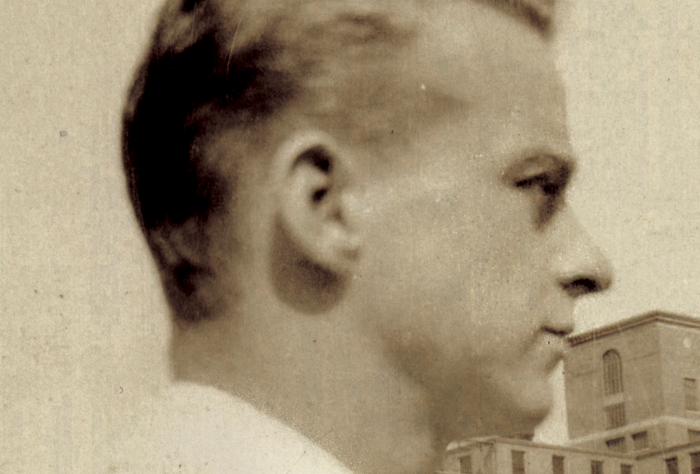
The stories of lives affected by mental illness are often filled with questions, possibilities, and what-ifs. Of myriad futures unexplored. Yet, sometimes there are clues, evidence that can be pieced together and viewed through the lens of time to build a plausible, probable story of what a life might have been.
In the case of Perry Cossart Baird Jr., MD ’28, it’s easy to imagine what might have been.
“Now, this is an interesting picture,” says Mimi Baird, holding a small photo of her father Perry. Mimi, a retired hospital administrator, stands at the kitchen counter of her home in Woodstock, Vermont, hovering over a stack of yellowed clippings and scrapbooks. At 81, she is the guardian of her father’s legacy and co-author of He Wanted the Moon: The Madness and Medical Genius of Dr. Perry Baird, and His Daughter’s Quest to Know Him, a 2015 memoir constructed from a long-lost manuscript handwritten by her father. The manuscript, together with letters and other documents related to Baird’s life and work, are housed in the Center for the History of Medicine at the Francis A. Countway Library of Medicine.
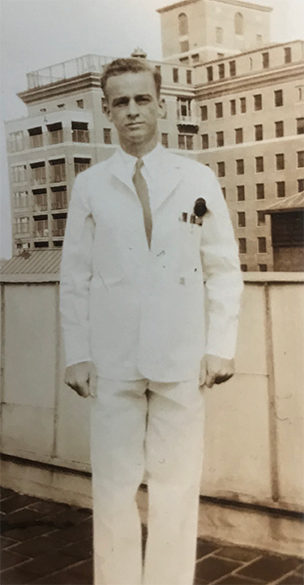
“It was taken at Harvard Medical School,” she adds. “This is him. You’ve got the pens in the pocket, the whole outfit.” In the photo, Baird wears the fresh whites of a young medical student and faces the camera, his expression flat, dignified, with only a half-smile hinting at his assurance, the certainty he is destined for great things.
“I think Dr. Means saw him taking over the general internal medicine department at the MGH,” she says, referring to Massachusetts General Hospital and James Howard Means, MD 1911, a friend and mentor of her father’s. “I interviewed somebody out in Texas, and they said he could have been an Everett Koop.”
In an alternate timeline, Baird would have had an opportunity to fulfill the almost unlimited potential he flashed as a young researcher and, today, his name might occupy the same place of honor as the medical and scientific men who trained, mentored, and groomed him for success—Means, Fuller Albright, MD ’24, and Walter Bradford Cannon, MD 1900.
The Perry Baird known to many of his contemporaries was a handsome, fashionable man of privilege, tall and broad, confident in his talents and abilities; a successful dermatologist in the Boston area with a thriving practice in a building on Commonwealth Avenue; a well-dressed charmer who belonged to The Country Club in Brookline and the Norfolk Hunt Club, where he owned three horses; a regular at the Ritz and the Satire Room, the jazz lounge at the Hotel Fensgate. Cutting an erratic trail through Boston Brahmin high society, Baird was a character out of an F. Scott Fitzgerald novel. But like the greatest of Fitzgerald’s characters, Baird’s gifts were tempered with darkness and, ultimately, tragedy.
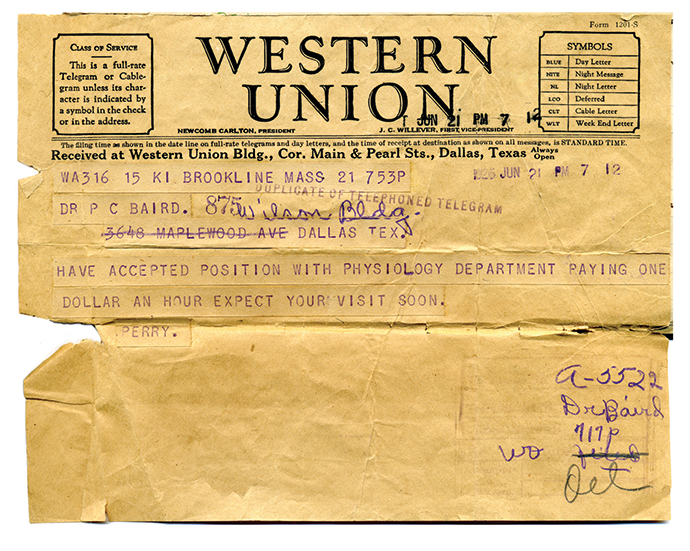
In 1934, Baird set out to do something many in the medical establishment deemed not only improbable, but impossible—provide biological evidence that psychiatric disease was a physiological rather than a psychological condition. His search would cost him his reputation, his career, his family, and his freedom. But his story is not solely about what was lost.
Shooting star
Growing up in Mexia, Texas, a small town on the Navasota River south of Dallas, Baird was an energetic, confident child, devoted to academics. He arrived in Boston in September 1924 to attend HMS. In his first year, he began working in the physiology lab of Alexander Forbes, MD 1910, and he distinguished himself as a dogged research scientist. By the end of his third year, Baird had co-authored three papers, all published in the American Journal of Physiology.
His intelligence and enthusiasm earned the attention of Forbes’ mentor, Cannon, the chair of the School’s Department of Physiology. At that time, Cannon was at the height of his influence and scientific fame. In him, Baird found more than a mentor; he found a role model.
Baird graduated at the top of his class at HMS and completed his internship at University Hospital in Ann Arbor, Michigan. In 1930, he returned to Boston to begin his residency at Mass General, intent on following in Cannon’s footsteps.
But Cannon and Means had other plans. They thought Baird the perfect candidate to bring dermatology at Mass General into the modern age and arranged for him to begin a one-year residency under John H. Stokes, a noted expert in dermatology and syphilology at the University of Pennsylvania in Philadelphia. Before completing that residency, however, Baird traveled to Buffalo at the request of Albright, himself a rising star in the burgeoning field of endocrinology, to observe a new medical procedure for treating patients with Addison’s disease, a life-threatening condition in which the adrenal glands fail to produce sufficient amounts of cortisol and aldosterone.
Baird graduated at the top of his class at HMS and completed his internship at University Hospital in Ann Arbor, Michigan.
Upon his arrival in Buffalo, Baird wrote to his parents: “a Dr. Hartman has developed a process by which a substance can be extracted from animal glands and used to keep these patients alive indefinitely. Three of these patients were dying under our eyes. Extract was shipped to us. We injected it. The dying came back to life and to health. Dr. Hartman can supply us only for six weeks. After that, we must make our own ‘Cortin.’ I have been sent to Buffalo to learn the process. It will require ten days to two weeks. I expect to be working day and night.”
Together, Baird and Albright began work on a paper detailing this new treatment and the role of the adrenal cortex in the production of corticosteroids. In the fall of 1932, Baird, now living in Philadelphia, sent Albright an early draft of the paper. Albright responded with a detailed list of edits. The edits sparked two dense replies from Baird, each crackling with energy: “Send me that curve on the effect of pituitrin, and I will send you my I.O.U. for six bottles of champagne.”
Days later, Means found Baird wandering the streets of New York City in the midst of a severe manic episode. Recognizing Baird’s distress, Means arranged for him to be transported to Philadelphia, where he was admitted to the Pennsylvania Hospital for Mental and Nervous Disorders.
Baird was 29 years old when he was admitted to the hospital in December 1932. Diagnosed with manic depressive psychosis, today known as bipolar disorder, he spent much of his hospitalization in a medically induced coma. When he emerged after 25 days, he found the course of his life had been permanently altered.
The episode cost Baird his fellowship, and his chance at becoming a professor of dermatology at HMS. But it didn’t cost him his mentors. Means and Cannon offered their support, suggesting he move back to Boston and open a private practice. Baird accepted the advice and, along with his new wife, Gretta, returned to Boston to begin a life as a private practitioner.
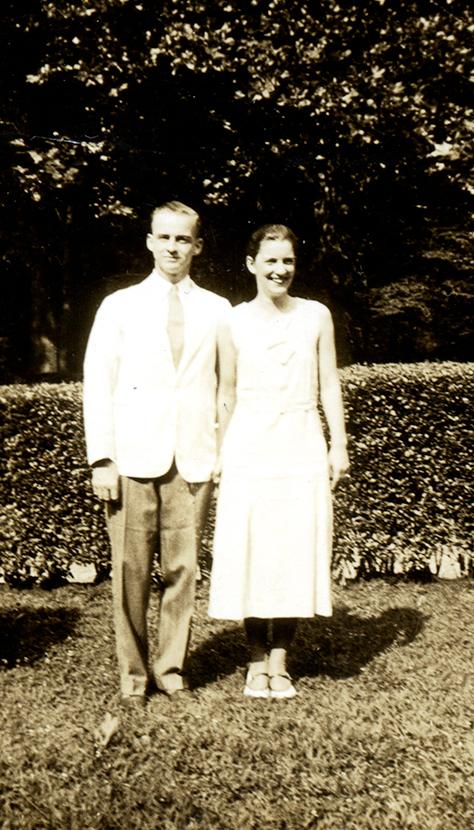
Underneath, he remained a man on fire, full of questions and ready to seek answers.
The state of the art
The idea that mental illness is biological in nature, as opposed to simply imagined or invented, wasn’t new. In fact, at the turn of the twentieth century, it was the prevailing notion. Prominent clinicians such as the German psychiatrist Emil Kraepelin—who coined the term manic depressive insanity—theorized that mental illness was a form of intoxication, or “self-poisoning,” caused by either an excess or lack of some naturally occurring biological substance. Despite broad agreement on the merits of this theory, scientists were unable to provide empirical evidence to back it up. Adolf Meyer, the first psychiatrist-in-chief at Johns Hopkins, wrote: “As long as chemistry can not [sic] furnish more accurate data and methods, the theory of intoxication and autointoxication so often resorted to by Kraepelin will be a terminus technicus for our ignorance.”
Lacking a solid scientific foundation, the autointoxication theory stalled, gradually ceding ground to another emerging school of thought. By the 1920s, psychoanalysis, which posits that mental illness is the result of unconscious conflicts or repressed memories, was on its way to becoming the dominant force in clinical psychiatry in the United States.
Baird, with his diagnosis of manic depressive illness, entered a world in which psychoanalysis reigned. From his doctors and colleagues to his friends and family, the consensus was that Baird’s problems were not only of his own making but also in his hands to control.
In the manuscript that became He Wanted the Moon, Baird captured some of these character assessments. “All Perry’s troubles are sexual,” he overheard one physician colleague say. According to his psychiatrist, Baird’s manic episodes would be controllable provided he stay away from whiskey. And a hospital psychiatrist offered him this advice: “live a regular life, eat and sleep regularly. Have sexual intercourse about three times per week. Reduce your income to $15,000 per year. Don’t overwork. When you feel yourself getting manic, just don’t talk so much.”
But Baird was an empiricist, a physiologist. He rejected the abstractions of psychoanalysis, believing there had to be a biological explanation for his psychosis. In 1933, shortly after his release from his first hospitalization, Baird wrote to Cecil Drinker, a physiologist and former dean of what was then the Harvard School of Public Health:
“Analytical and synthetic thinking of a physiological variety is surely one of the great delights of living. The one thing which I most love to do is physiological research of a nature which is open to procedures which can be carefully controlled. More specifically speaking, I cannot suppress my burning desire to continue my studies of the relationship between the anterior pituitary gland and the adrenal cortex. I am convinced that such research would yield a steady harvest of interesting data.”
Baird’s scientific mind was busy connecting dots. Drawing on his work with Albright, as well as earlier work by Cannon that described the role of adrenaline in states of intense emotion, Baird hypothesized that a malfunctioning adrenal cortex might be to blame for his condition.
On a mission
At the same time he was settling into his new life as a practicing dermatologist, Baird was using a laboratory provided by Cannon to conduct an observational experiment to test his theory. Employing a technique pioneered by Cannon, Baird surgically removed the adrenal glands of twenty cats, then separated the animals into two groups. One group received abdominal injections of blood drawn from patients with mania at McLean Hospital; the other group, the control, received blood from healthy individuals.
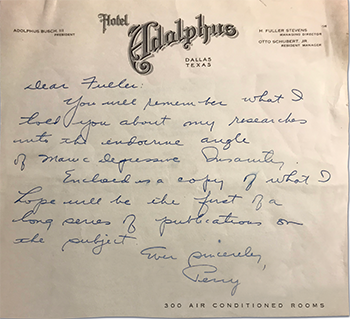
By the end of the experiment, the animals that received blood from patients with mania had lived 40 percent longer than those in the control group. Although the reason for this was unclear, and did not provide him the insight he’d hoped for, it was enough to convince him he was on to something.
On November 3, 1934, Baird wrote to Cannon asking permission to continue his experiments: “We would carry on with our effort to determine whether or not it can be demonstrated biologically that the blood of a patient in a manic state can be distinguished from a normal blood similarly tested.”
Eight days later, Baird was admitted to McLean. He was, he wrote, “over-active, euphoric and excited.”
According to hospital records, he became violent, smashing furniture and windows, and threatening staff. He was released a month later.
In a letter penned shortly after Baird’s release, Cannon wrote: “Everybody has a critical stress which he can stand. … The prudent person is one who learns by careful observation where that stress lies and manages his life so that he lives within the limits.” At the urging of Cannon and Means, Baird agreed to abandon his research into the cause of manic depression.

He again settled into domestic life with Gretta. They became the parents of two daughters, Mary Stewart (Mimi) and Catherine (Kitsy). Baird’s practice thrived, thanks in part to the steady stream of patients referred to him by Cannon, Means, and others.
Yet Baird still wanted answers. He succeeded in again enlisting the support of Cannon, Means, and Kenneth Tillotson, then psychiatrist-in-chief at McLean. In 1940, he resumed his research; by the spring of 1942, he had completed a paper reporting his findings.
The vortex of his disease, however, proved inescapable. In early May 1942, he was readmitted to the Pennsylvania Hospital for Mental and Nervous Disorders. He escaped days later.
Over the next year, as Baird polished his article for submission, he was hospitalized five more times, the fifth time in February 1944 in the Westborough State Hospital in Massachusetts.
The paper that had haunted Baird for a decade came out two months later in the Journal of Nervous & Mental Disease while he was still hospitalized at Westborough. Around the same time, Gretta filed for divorce. Shortly after, he received word that his medical license had been revoked.
While earlier drafts of Baird’s paper included Cannon and Tillotson as co-authors, the final published version lists only Baird. As with his earlier experiment, his results were promising but inconclusive. In the paper, Baird suggests the study is best viewed as proof of concept, a justification for deeper inquiry, and a reluctant recognition of personal limitations:
“This paper is preliminary in nature but is published at this time because of the necessity of postponing further experimentation for an indefinite and uncertain amount of time. Perhaps this report will stimulate added interest in the manic psychosis as a physiological and general medical problem rather than as a purely psychological one. It may be hoped that other investigators will continue these studies.”
Baird had once hoped to complete a series of papers on manic psychosis, but even his calls for continued study went unanswered. “Biochemical Component of the Manic-Depressive Psychosis” would be cited only five times, the last in 1952.
Lonely are the brave
It’s difficult to point to a single reason why Baird’s study went largely unrecognized. As He Wanted the Moon points out, the paper came out at the height of World War II, when many of Baird’s colleagues were overseas. Baird may also have been the victim of bias, based on the stigma of his own particular mental illness.
“Bipolar, at the time, was very much the neglected psychosis,” says Anne Harrington, the Franklin L. Ford Professor of the History of Science at Harvard and the author of Mind Fixers: Psychiatry’s Troubled Search for the Biology of Mental Illness. “In contrast to schizophrenic patients, who were often seen as pliable lost souls, there was often less interest in working with bipolar patients, because they tended to be viewed as both very smart and manipulative.”
Perhaps this report will stimulate added interest in the manic psychosis as a physiological and general medical problem rather than as a purely psychological one. It may be hoped that other investigators will continue these studies.
There are indications that Baird’s colleagues took the view that his research was just a complicated way of rejecting his own responsibility for the havoc he wreaked. Today, some think Baird’s thinking was simply ahead of its time.
“I suspect his ideas were too far out there for the 1940s,” says Ross Baldessarini, an HMS professor of psychiatry who founded and directs the International Consortium for Bipolar & Psychotic Disorders Research at McLean. Baldessarini is one of a handful of researchers of bipolar disorders who have rediscovered Baird’s work, thanks in part to the efforts of Mimi Baird and the publication of He Wanted the Moon.
In Baldessarini’s view, Baird was a pioneer in looking for objective evidence, even if his work failed to yield any clear-cut explanations for the cause of a major mental illness.
“He was no worse off in that regard than we are today because we still don’t know,” Balsessarini adds.
In his quest to find a biochemical cause for bipolar disorder, Baird was seeking understanding. In this way, his paper has more in common with modern approaches like psychiatric genetics, which tend to focus on pathogenesis and the identification of biomarkers, than with the psychoanalysis-heavy publications of his time.
“This is a case of somebody who is looking for a cause, not a cure, and that’s important to note,” says K. Sue O’Shea, director of the University of Michigan Center for Pluripotent Stem Cell Research.
“He wasn’t trying to alleviate suffering in the short term,” she adds. “He was attempting to shift the paradigm in psychiatry with testable hypotheses. You really need to understand the biochemical basis of the disease to develop rational treatments.”
As part of her research, O’Shea is using stem cells derived from patients with bipolar illness to model the disease in living tissue.
Proof of concept
There is one final turn to Baird’s story, one that adds poignancy and a sense of what biomedicine lost to his illness.
Four years after Baird’s paper and half a world away, John Cade, a 37-year-old psychiatrist and former prisoner of war working at the Bundoora Repatriation Mental Hospital outside of Melbourne, had an idea that the blood chemistry of his patients with mania might differ from that of healthy participants. Using a converted kitchen as a lab, Cade, unaware of Baird’s research, tested his hypothesis by injecting blood and urine from patients with manic disorders into guinea pigs.
When results indicated that the procedure caused toxic levels of uric acid, Cade added lithium salts to his solution as a dissolving agent. To his surprise, the lithium solution had a visibly soothing effect on the animals. That moment of serendipity led to one of the more significant pharmacological breakthroughs of the twentieth century—the discovery of lithium carbonate for the treatment of bipolar disorder.
Cade’s breakthrough arrived too late to save Baird. In September 1949, when Cade published his findings in The Medical Journal of Australia, Baird was confined to the State Psychopathic Hospital in Galveston, Texas, awaiting a prefrontal lobotomy. After the surgery, Baird lived with his parents and brother in Texas before moving to Detroit in 1959 to take a job as an ambulance attendant. He died on May 4, 1959, following a seizure in the bathtub of his boarding house.
Cade would go on to be celebrated as one of the pioneers of modern psychiatry, while Baird slipped quietly from history.
Paul Goldsmith is a Boston-based writer.
Images: Fuller Albright papers, 1904-1964, 1990. H MS c72. Harvard Medical Library, Francis A. Countway Library of Medicine (letter to Albright); all other images courtesy of Mimi Baird.